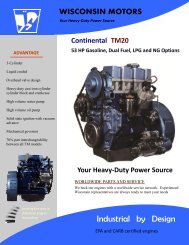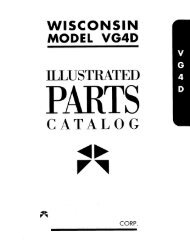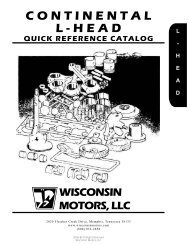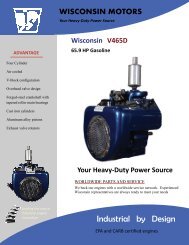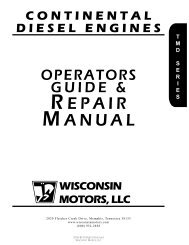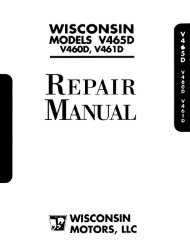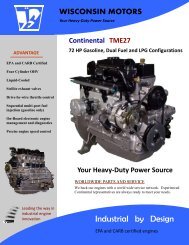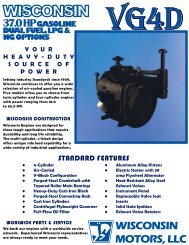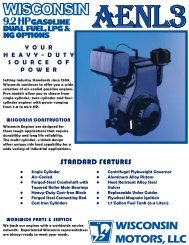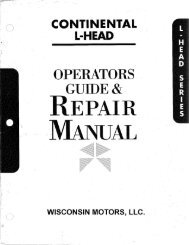WISCONSIN MODEL VG4D - Wisconsin Motors
WISCONSIN MODEL VG4D - Wisconsin Motors
WISCONSIN MODEL VG4D - Wisconsin Motors
You also want an ePaper? Increase the reach of your titles
YUMPU automatically turns print PDFs into web optimized ePapers that Google loves.
Loose connections at ignition cable.<br />
~iagneto or Distributor breaker points pitted or worn.<br />
~Vater in gasoline.<br />
Poor compression. ,~ee ’Compression’, Page 17.<br />
ENGINE SURGES OR GALLOPS<br />
Carburetor flooding.<br />
Governor spring hooked into wrong hole in lever. ,gee<br />
’G~’ernor ldjustment’, Page 24. Governor rod incorrectly<br />
adjusted. See ’Governor Adjustment’, Page 24.<br />
ENGINE STOPS<br />
Fuel tank empty.<br />
Water, dirt or gum in gasoline.<br />
Gasoline vaporized in fuel lines due to excessive<br />
heat around engine (Vapor Lock). See ’Stopping<br />
gine’, f~age 9.<br />
Vapor lock in fuel lines or carburetor due to using<br />
winter gas (too volatile) in hot weather.<br />
Air vent hole in fuel tank cap plugged. Engine scored<br />
or stuck due to lack of oil.<br />
Ignition troubles. Fee ’Ignition’, Page 17.<br />
ENGINE<br />
OVERHEATS<br />
Crankcase oil supply low. Replenish immediately.<br />
Ignition spark timed wrong. ,See "~lagneto Timing’,<br />
Page 12, or ’Distributor-Battery Ignition’, Page 13.<br />
Low grade of gasoline.<br />
Engine overloaded.<br />
Restricted<br />
cooling air circulation.<br />
Part of air shroud removed from engine.<br />
Dirt between cooling fins on cylinder<br />
or head.<br />
Engine operated in confined space where cooling air<br />
is continually recirculated, consequently becoming<br />
too hot.<br />
Carbon in engine.<br />
Dirty or incorrect<br />
Restricted<br />
exhaust.<br />
grade of crankcase oil.<br />
Engine operated while detonating due to low octane<br />
gasoline or heavy load at low speed.<br />
ENGINE KNOCKS<br />
Poor grade of gasoline or of low octane rating. See<br />
’Fuel’, Page 8.<br />
Engine operating<br />
under heavy load at low speed.<br />
Carbon or lead deposits in cylinder head.<br />
Spark advanced too far. See ’.~Iagneto Timing’, Page<br />
12, or ’Distributor-Battery Ignition’, Page 13.<br />
Loose or burnt out connecting rod bearing.<br />
Engine overheated due to causes under previous<br />
heading.<br />
Worn or loose piston pin.<br />
ENGINE BACKFIRES THROUGH CARBURETOR<br />
Water or dirt in gasoline.<br />
Engine cold.<br />
Poor grade of gasoline.<br />
Sticky inlet valves. See ’Valves’, Page 22.<br />
Overheated valves.<br />
Spark plugs too hot. See ’Spark Plug’, Page 15.<br />
Hot carbon particles<br />
in engine.<br />
DISASSEMBLY AND REASSEMBLY<br />
OF <strong>VG4D</strong> ENGINE<br />
Engine repairs should be made only by a mechanic<br />
who has had experience in such work. When disassembling<br />
the engine it is advisable to have several<br />
boxes available so that parts belonging to certain<br />
groups can be kept together, such as, for instance,<br />
the cylinder head screws, etc. Capscrews of various<br />
lengths are used in the engine, therefore great care<br />
must be exercised in reassembly so the right screw<br />
will be used in the various places, otherwise damage<br />
may result.<br />
Tighten the cap screws and nuts of the manifolds,<br />
cylinder heads, gear cover, oil pan, connecting rods,<br />
cylinder blocks, main bearing plate and the spark<br />
plugs to the specified torque readings indicated in<br />
the following paragraphs of reassembly.<br />
While the engine is partly or fully dismantled, all of<br />
the parts should be thoroughly cleaned. Remove all<br />
accumulated dirt between the fins.<br />
If it is desired to disassemble the engine, the following<br />
order should be substantially adhered to. As<br />
disassembly progresses, the order may be altered<br />
somewhat if desired, as will be self-evident to the<br />
mechanic. Reassembly of the engine should be made<br />
in the reverse order.<br />
TESTING<br />
REBUILT ENGINE<br />
An engine that has been completely overhauled, such<br />
as having the cylinders rebored and fitted with new<br />
pistons, rings and valves, should go through a<br />
thorough "run-in" period, before any amount of load<br />
is applied to the engine.<br />
The engine should be started and allowed to run for<br />
about one-half hour, at about 1200 to lzt00 R.P.M.<br />
without load. The R.P.M. should then be increased to<br />
engine operating speed, still without load, for an<br />
additional three and one-half to four hours.<br />
The proper "running-in" of the engine will help to<br />
establish polished bearing surfaces and proper clearances<br />
between the various operating parts and thus<br />
add years of trouble free service to the life of your<br />
engine.<br />
18



